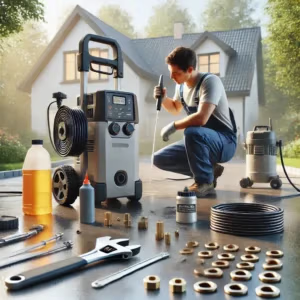Pressure Washer Maintenance and Troubleshooting: The Ultimate Guide to Keep Your Equipment Running Smoothly
A pressure washer is a powerful tool for tackling tough cleaning jobs around your home and business. But like any piece of equipment, it requires regular maintenance to ensure peak performance. In this guide, we’ll cover pressure washer maintenance and troubleshooting tips to help you keep your equipment running smoothly, avoiding costly repairs and downtime.
To ensure you’re using the right equipment, check out our guide on pressure washing equipment.
Why Regular Pressure Washer Maintenance is Important
Routine maintenance is essential for any pressure washer, whether gas-powered or electric. Neglecting regular upkeep can lead to problems like reduced water pressure, sputtering engines, or even a complete breakdown.
To ensure proper care, it’s important to know the differences between pressure washing and soft washing. Learn more in our detailed comparison guide.
The Essential Maintenance Checklist for Your Pressure Washer
To keep your pressure washer in top shape, follow this maintenance checklist:
1. Check the Oil Level
For gas-powered models, regularly inspect the oil level. Low oil can cause severe engine damage. Change the oil every 50 hours of use or as recommended by the manufacturer.
2. Clean or Replace the Air Filter
A clogged air filter reduces engine performance. Check it before each use and clean or replace it as needed. For heavy-duty users, it might be necessary to replace the air filter monthly.
3. Inspect the Water Inlet Filter
The water inlet filter prevents dirt and debris from entering your pressure washer. Clean it regularly to avoid blockages that could affect water flow.
To prevent equipment damage, make sure to avoid common mistakes when pressure washing. Read our guide on common mistakes to avoid when pressure washing.
4. Check the High-Pressure Hose
Look for any signs of wear, leaks, or cracks in the high-pressure hose. A damaged hose can burst under pressure, causing injury or equipment damage. Replace the hose if any defects are found.
5. Flush the System with Clean Water
After each use, flush your pressure washer system with clean water. This helps remove detergent residue and debris, preventing clogs and ensuring smooth operation.
6. Lubricate All Fittings
To prevent rust and ensure smooth movement, lubricate all fittings and O-rings with a high-quality lubricant. This simple step can prevent leaks and prolong the lifespan of your pressure washer components.
Common Pressure Washer Troubleshooting Tips
Despite your best efforts with maintenance, problems can still arise. Here are some troubleshooting tips to quickly diagnose and fix issues.
1. Low or Fluctuating Water Pressure
- Cause: Clogged nozzle, dirty water filter, or kinked hose.
- Solution: Clean the nozzle first. If the issue persists, check the water filter and hose for clogs or damage.
2. Engine Won’t Start
- Cause: No fuel, low oil level, or dirty spark plug.
- Solution: Check the fuel and oil levels first. If both are adequate, inspect the spark plug and clean or replace it if necessary.
3. Water Leaks from the Pump
- Cause: Worn-out seals or O-rings.
- Solution: Inspect the pump and replace any damaged seals or O-rings. Applying a lubricant can also help prevent future leaks.
4. Pressure Washer Shuts Down During Use
- Cause: Overheating, low oil, or a blocked air filter.
- Solution: Let the machine cool down before restarting. Check the oil level and clean the air filter. If the problem continues, consult a professional.
Pro Tips for Extending the Life of Your Pressure Washer
✅ Store in a Cool, Dry Place – Avoid exposing your pressure washer to extreme temperatures. Store it in a cool, dry place to prevent engine and pump damage.
✅ Use the Right Detergent – Only use detergents specifically designed for pressure washers. Using the wrong type can clog the system and damage internal components.
✅ Winterize Your Pressure Washer – Before storing your pressure washer for winter, drain all water and add antifreeze to prevent freezing.
✅ Wear Proper Safety Gear – Using a pressure washer comes with risks, so ensure you have the right protective equipment. Learn more in our safety gear guide.
✅ Prevent Mold and Mildew Buildup – Pressure washing isn’t just for cleanliness—it helps prevent mold and mildew growth. Read our guide on how pressure washing helps prevent mold and mildew.
How Around The Bend Pressure Washing Can Help You
Maintaining a pressure washer can be time-consuming and challenging, especially if you’re unfamiliar with the equipment. At Around The Bend Pressure Washing, we provide professional cleaning services and expert advice on pressure washer maintenance.
Our Services Include:
✅ Pressure Washing – High-powered cleaning for driveways, siding, and decks.
✅ Roof Cleaning – Safe soft washing techniques for mold and algae removal.
✅ Gutter Cleaning – Prevents water damage by removing debris.
✅ Concrete Cleaning – Keeps sidewalks, patios, and driveways spotless.
Based in Tallahassee, FL, we serve both residential and commercial clients, ensuring top-quality results with cutting-edge equipment.
📞 Contact Us Today:
📧 Email: [email protected]
📞 Call: 850-888-2105
Let our expert team help you maintain clean and well-maintained surfaces effortlessly! 🚀


1 thought on “Pressure Washer Maintenance and Troubleshooting: The Ultimate Guide to Keep Your Equipment Running Smoothly”
Pingback: Ultimate Guide: Must-Have Pressure Washer Accessories for a Perfect Clean - Tallahassee Pressure Washing Services